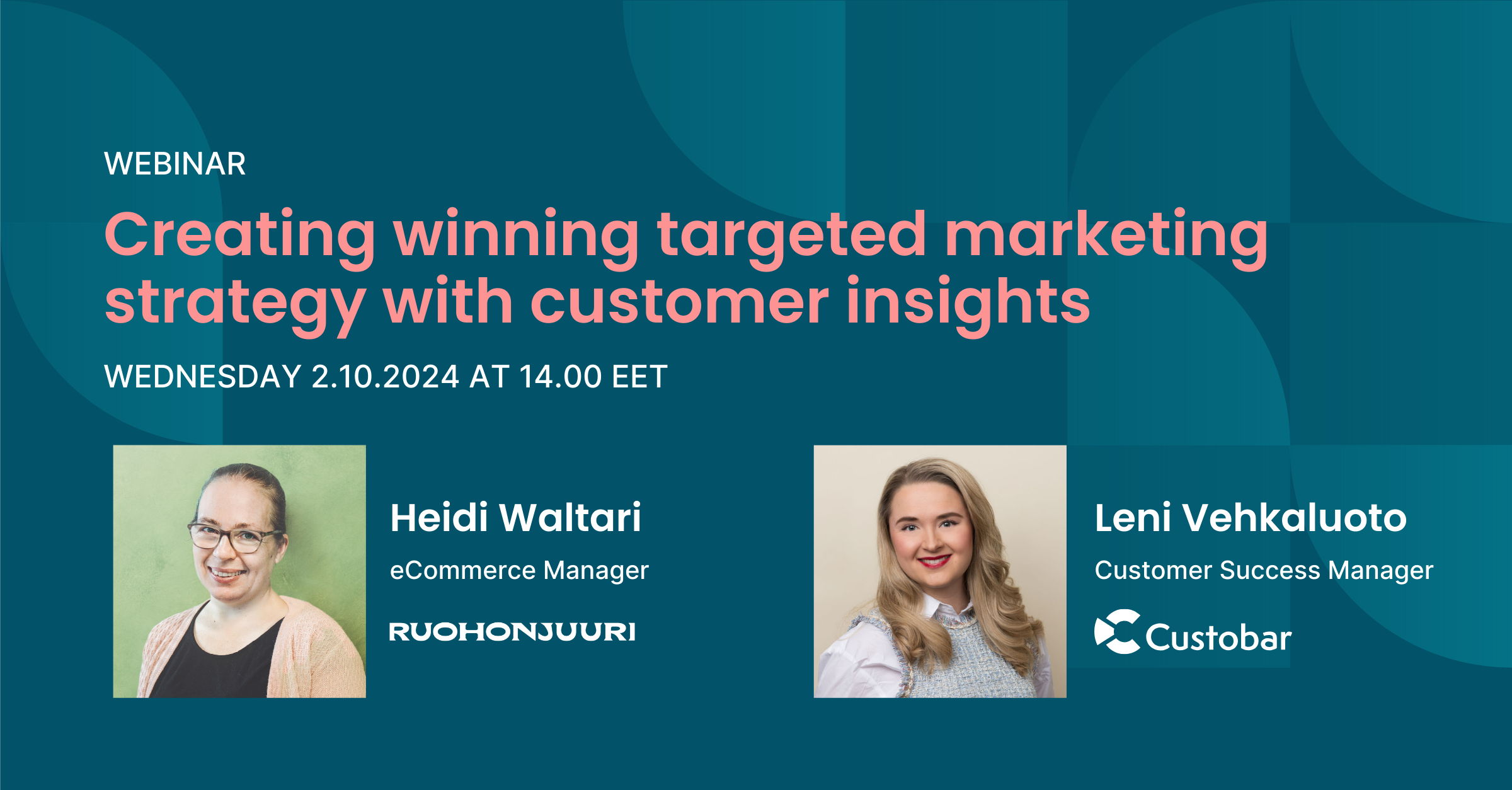
Creating winning targeted marketing strategy with customer insights
Are you ready to transform your marketing strategy? Watch an insightful webinar with Ruohonjuuri, tailored specifically for e-commerce and omnichannel retailers.

Are you ready to transform your marketing strategy? Watch an insightful webinar with Ruohonjuuri, tailored specifically for e-commerce and omnichannel retailers.

Custobar
30. November 2023
Turning passive customers into active ones is an essential strategy for any business. These customers might seem unimportant, but they often make up a significant portion of your customer base. In this article, we'll share four tips on how to activate these customers and why it's crucial to do so.
There are three primary reasons to focus on re-activating passive customers:
Moreover, if your loyalty programme includes a large number of passive members, it might not be considered successful. You not only risk losing valuable customers but also harm your company's reputation.
Identifying passive customers is straightforward if you're utilising tools like Custobar's RFM matrix. Coupling it with audience & customer search simplifies the process.

Avoid relying on a single email automation for passive customers. Instead, utilise various channels (emails, SMS, Google Ads, Facebook, WhatsApp etc.) to communicate with them. Remember, each channel should convey a unique message to avoid repetition, or you can reach out to each customer via the channel they respond best to. In a CDP, your customer data helps you to do this.
SMS campaigns are especially successful, also in activating passive customers. Their conversion is excellent because their click-through rates are good and there is less competition. But do not overuse them, consumers have a minimal tolerance for messages that even slightly resemble spam. An excessive number of SMS messages can cease to drive sales and instead lead to a rise in the rate of unsubscriptions.
For marketers, the most significant advantage lies in achieving "passive income". Once activated, automation takes charge and works tirelessly on your behalf. Of course, it's important to maintain and manage the automation, but rest assured, it will consistently generate income with minimal daily effort.
Furthermore, automated campaigns are preferable to manual sendings due to sender reputation concerns. Automations send out individual email dispatches, thereby avoiding possible damage to your sender's reputation.
When starting a campaign, consider either sending an email to everyone in the customer segment or only to new members.

The first configuration prompts a large sending, which can be minimised with enhanced filtering. Rather than aiming at "all passives for 6M (months) or more", a more advantageous target would be “6 months to the day".
The second configuration sends emails only to those who newly enter the segment and any existing ones would not be contacted. By skipping over these customers there is a significant chance that many of them will never receive any communication. Thus, you must consider whether maintaining a good sender reputation (option 2) holds more weight than reaching all of your passive customers (option 1). It could be argued that it does.
Also, due to GDPR and other data protection regulations, there comes a time to consider if a passive customer should just be deleted after being passive long enough. How long is “long enough” is a matter for your company and your company’s legal advisors to determine.
When you establish a process for re-engaging passive customers, you have the ability to preset the timeframe and corresponding actions that will trigger whenever a customer's inactivity reaches a particular milestone (such as 3 months, 6 months, 9 months, and so forth). This ensures you're always implementing the appropriate measures at the correct time to re-activate idle customers, without damaging your sender's reputation with email delivery systems.
The only thing left is to track the results, reap the benefits, and optimise the actions or the timeline whenever necessary.
Activating passive customers is one of the critical key performance indicators (KPIs) you should focus on. However, we also know the benchmarks for the best possible KPI results.
Let’s say that a client has a total number of 82 200 contacts. In that case, your benchmarks for the total percentage of customers who have become passive are:
In practice, the average conversion rate for automated activating messages (3-12 months) is 2%, but we see conversions as high as 6% If an average purchase is worth 90 euros, with a 2% conversion rate that means 1 644 people who make a purchase, and a total number of sales that results in 147 960 euros. Fully automated. Just replace with your numbers and do the math - setting up an automation to activate passive customers quickly pays for itself.
Remember that these strategies should be tailored to the nature of your business and customer base. The conversion timeline for buying a car is different from buying socks. Always keep an eye on your key performance indicators (KPIs) and adjust your strategies as needed.

How do you tell the most relevant customers apart from the crowd, and how should you be communicating with them?

Facebook gives marketers a multitude of parameters to pick from when targeting ads. Finding the perfect audience from the 2,7 billion active Facebook users is surely not a piece of cake.

The high costs of advertising and discounts during the peak season of BFCM mean retailers need to strategise to retain new customers and ensure long-term growth.